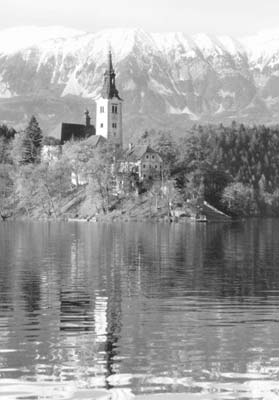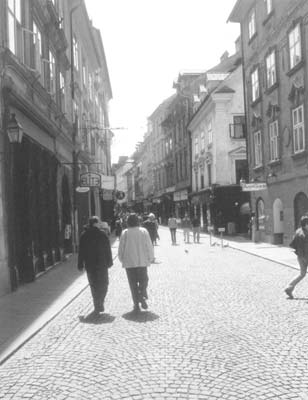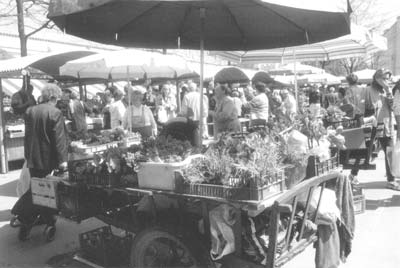Slovenia: the sunny side of the Alps
by Jack C. Ogg, Houston, TX; part 1 of 3 on the Balkans
Slovenia, a small gem of a country set between Italy, Austria, Hungary and Croatia, is a combination of Alpine beauty, majestic valleys and blue- and turquoise-colored lakes purified by their limestone surroundings. The population of nearly two million is neatly distributed over its 20,000 square kilometers, with the only near-metropolis being the capital city of Ljubljana (pronounced Lubliana), a city of only 275,000.
The flight in
Although no direct flights from the U.S. connect with Slovenia, its national airline, Adria Airways, flies between Slovenia and some 20 major European cities, making one-stop service from the U.S. simple.
We flew from Houston to London Gatwick Airport on Continental, arriving at 6:45 a.m. Our Adria Air connection left Gatwick at 9:45 a.m. and we arrived in Ljubljana two hours later.
The London flight path came down the Slovene Alpine valley past Mount Triglav — a sacred mountain and national symbol represented upon the country’s seal — and past the city and lake of Bled, one of the most beautiful sights in our travel experience.
After landing and quickly clearing Customs at Ljubljana’s airport, which is at once efficiently modern and as convenient and welcoming as the old-world aerodromes of yesteryear, we obtained our Budget rental car and headed up the valley to Bled, located only half an hour from the airport.
Bled
Lake Bled, with the surrounding town, the lake’s central island topped by a steepled church, and Bled Castle perched more than 100 meters above the lake’s waters, is the poster child of Slovenian travel literature.
There are at least three topflight hotels in Bled, all of them on the lake.
Hotel Vila Bled (Cest Svobode 26; phone 386 4 5791 500 or e-mail vila bled@relaischateaux.com), a Relais et Châteaux property, is situated on the tranquil lakefront, just one kilometer from the town center.
The Grand Hotel Toplice (C. Svobode 12; phone 386 4 579 1000 or visit www.hotel-toplice.com), also in the town center, is a grand old-world hotel with a picturesque situation on the lake directly across from Castle Bled.
The Park Hotel (Cesta Svobode 15; phone 386 4 579 3000 or e-mail recpark@gp-hoteli-bled.si) is the largest and most active, as it is next to Casino Bled in the town center and amidst the many shops of the town’s commercial district.
We chose the Grand Hotel Toplice, splurging for a suite ($225 including breakfast) with a large balcony overlooking the mirrored lake, which reflected the castle, the island and the surroundings.
After a short nap and drinks on our romantic balcony, we drove to Hotel Vila Bled and enjoyed another toast amidst its tradition and charm. It was originally a Habsburg prince’s mansion and between the world wars served as a summer residence for Yugoslavia’s then royal family. Afterward, it became Marshal Tito’s presidential residence until, in 1984, it was remodeled into the Vila Bled.
We returned to our hotel and walked along the lake to the rowboat lock, where we hired a boat, guide and rower, all in one, to take us across the placid waters to the island. Power-driven boats are not allowed on Lake Bled, preserving its charm, beauty and tranquility. While enjoying the peaceful trip out, we were passed by several scullers, one of whom shot past us at phenomenal speed. He was, we learned, one half of Slovenia’s Olympic championship 2-man rowing team.
At the island, we climbed the hundred steps to the Baroque Church of the Assumption. The church is notable for its fresco fragments from the 14th century and a large gold altar. Under the pre-Romanesque chapel, a part of the apse is covered with glass to allow a view of part of the ancient original foundation. The church is not large and appears to be used primarily for weddings, baptisms and special occasions.
A rope near the altar rings the bell in the 15th-century belfry. According to legend, if you make a wish and ring the bell, your wish will come true. We, of course, each made a wish.
Back in the town, we dined beneath the stars on the Restaurant Okarina’s (Riklijeva 9) torch-lit outdoor patio, decorated with traditional musical instruments. We enjoyed pasta Bolognese, salad, whitefish and cream cake, with a carafe of the local white wine. Our meal for two cost $40 including tip.
After a walk back to the hotel and a good night’s sleep, we were up early for Connie’s massage and my workout in the exercise room. Breakfast — a bountiful buffet spread and any à la carte treat our hearts desired — was served in one of the hotel’s large dining rooms.
Ljubljana
We left Bled reluctantly, driving past Slovenia’s prettiest golf course, Club Bled, and the Alpine flying center and debating how soon we would pass this way again.
We reached Ljubljana swiftly on the expressway and cruised the city, crisscrossing the peaceful Ljubljanica River (the River of Seven Names) that meanders through the town.
Three unusual bridges span the river. The marketplace-area Dragon Bridge, ornamented with the town’s dragon mascots, was built with concrete and steel — one of the first bridges of this type in Europe.
Next came the unique Triple Bridge, an old stone bridge from the 1800s with two side bridges, added in the 1930s, forming an elegant entrance to the Old Town.
Farther down the river is the Cobblers’ Bridge, once roofed and lined with the workshops of artisans in the fashion of Florence’s Ponte Vecchio. The Cobblers’ Bridge even had an upper gallery before its modernization by the noted Slovenian architect Jose Plecnik in the 1930s.
Few towns or cities in the world owe their impressions to one artisan as does Ljubljana, in its beauty and charm, to its native son Jose Plecnik. His urban development of high obelisks, pyramids and columns, his arrangements of the riverbanks, his modernization of the bridges whilst retaining their character plus the indelible mark his commissions left on the current market, cathedral, central stadium and national library make him an icon of Slovenia.
We made a brief tour of the city by car, passing St. Nicholas’ Cathedral, its design and detail — Romanesque, Gothic and contemporary — revealing its partial rebuilding and additions to its 13th-century origins. We saw the Rotovz (the Town Hall), in front of which stands one of the city’s outstanding monuments, containing allegorical figures of the Sava, Krka and Ljubljanica rivers, along with the Hercules and Narcissus fountain.
Three linked Gothic squares — Town Square, Old Square and Upper Square — foot Castle Hill, the site of Ljubljana’s grad (castle). The castle itself, not yet fully restored and not open to the public at the time of my visit, began as a Roman fortification and became successively a medieval castle, a provincial prison and a seat of government prior to its abandonment and current restoration.
Three other large squares — French Revolution, Congress and Republic — front the historically important governmental buildings of the city.
The Teutonic Knights of Crusading times once held French Revolution Square, and it still contains some of the old walls. Congress Square was laid out for the Congress of the Holy Alliance of 1821 and is dominated by the more-than-50,000-student University of Ljubljana and the Slovene Philharmonic building. Republic Square is the city’s central forum, with the Parliament Building, the Cankarjev Dom Cultural & Congress Centre and various commercial establishments lining it.
We passed the National Library, the National Museum, the massive Ursuline Church of the Holy Trinity and some last vestiges of Imperial Rome, along with the Botanical Gardens, as we headed for the southern town of Lipica, near the Italian border.
Lipica
Our trip south on the modern expressway took us, in an hour, to the home of the noble white horse, the Lipizzaner. Many people associate the Lipizzaner with Austria or with Spain, because of the famous Spanish Riding School in Vienna. However, Lipica historically was the primary breeding center for Lipizzaner horses.
The stud farm lies in rolling hills, down a long lane lined with oak and linden trees, and while the feature attraction is the Lipizzaner, the complex (Lipica 5; visit www.lipica.org) also contains the Hotel Maestoso (named after a famous stallion) and Hotel Klub; the Casino Lipica; an 18-hole golf course with vista views at almost every tee box; tennis courts; swimming pools, and all the amenities of a great resort.
Even so, this picturesque environment begins and ends with The Horse. All types of pleasure riding and training classes, from beginner courses to expert dressage, are available. The stud farm was founded in 1580 and its more than 400-year history is now carried on by its Classical Riding Academy, which is the host to many European riding events.
Lipica was a last-minute addition to our itinerary, so we were unable to spend as much quality time there as we would have liked, but we cannot wait to return to that beautiful setting to ride, golf and watch the majestic white horses and the black colts and fillies that grow progressively whiter as they mature into alabaster Lipizzaners.
The Lipica region also has two large subterranean caves, a spa area and artists’ studios and is less than 30 minutes from Trieste, Italy, and the Adriatic Sea.
We headed back up the expressway through Ljubljana and the beautiful countryside toward the Croatian capital of Zagreb. Slovenia, which calls itself “the land on the sunny side of the Alps,” is, truly, a largely undiscovered marvel of mountains, lakes, vistas and old-world charm.
Next month the journey continues...to Croatia and the Dalmatian Coast.




